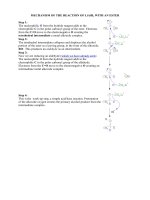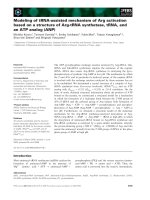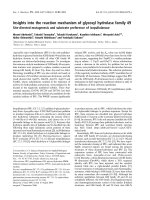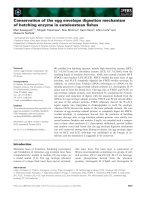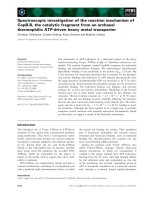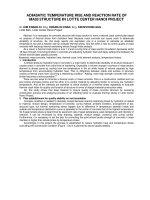PROJECT - REACTION MECHANISM OF REACTIVE DYES IN ON CELLULOSE FIBER.
Bạn đang xem bản rút gọn của tài liệu. Xem và tải ngay bản đầy đủ của tài liệu tại đây (926.3 KB, 61 trang )
PROJECT REPORT ON
REACTION MECHANISM OF REACTIVE DYES IN
BENGAL HURRICANE GROUP ON CELLULOSE
FIBER.
BASIS OF
BENGAL HURRICANE GROUP
Prepared By : Mazadul Hasan sheshir
ID: 2010000400008
13
th
Batch (session 2009-2013)
Department : Wet Processing Technology
Email:
Blog : www. Textilelab.blogspot.com (visit)
Southeast University
Department Of Textile Engineering
I/A 251,252 Tejgaon Dhaka Bangladesh
Prepared By :
©right
CONTENTS
•
Introduction
•
Raw Materials
•
Importance of The Survey
•
Reason of using Reactive dyes in major textile
industry in Bangladesh
•
Methods of Dyeing & Printing Cotton Goods
with Reactive Dyes
•
Technical Deficiency of Reactive Dyes, Causes
and Remedies of Technical Deficiency
•
Conclusion
Chapter 1
Acknowledgement
Project Work is an academic function of the Pabna Textile Engineering College. Our teacher Md. Abdul Mannan,
Principal, Pabna Textile Engineering College, gave us an opportunity to choose preferable mills for Project Work. I
chose Bengal Hurricane Dyeing & printing (pvt.) Ltd. joyfully with the supervision of Mithun Biswas, Asst.
Manager(production).
During the Project with Bengal Hurricane Dyeing & printing (pvt.) Ltd. I worked in all the departments related with
Dyes and Chemicals. Beside these, I learned about Dye Quality Control and Storage System,printing, Garments,
Store & Inventory , finishing & specially dyeing.
Our deepest appreciation goes to Mithun Biswas, Asst. Manager(production)Dyeing, Bengal Hurricane Dyeing &
printing (pvt.) Ltd. to give us the opportunity to have project work at BENGAL HURRICAN GROUP.
I would like to thank Engr. Md. Iqbal Mahamud (Head of the Factory), GM, Dyeing, Bengal Hurricane Dyeing & printing
(pvt.) Ltd. for helping to know about the all aspects of BENGAL HURRICAN GROUP.
I would also like to thank Tareq Ahmed(Deputy Manager),Md.Anwarul
Islam(Deputy Manager), Md. Arif Rabbani Talukdar(Deputy Manager),Dyeing, Bengal Hurricane Dyeing & printing (pvt.)
Ltd. for helping to know about the all aspects of BENGAL HURRICAN GROUP.
Our gratitude also goes to all the employees of BENGAL HURRICAN GROUP for their sincere co-operation, support and
valuable advice which they have provided us during the two months of training.
Lastly I express my gratitude to our supervising teacher, the name that should be mentioned first, Shib Shankar
Chakraborty, Head of the Dept. Wet Processing Technology for his valuable direction & supervision.
However, I have prepared my Industrial Attachment overcoming all the difficulties & also the shortage of time. Here I
would like to present the report.
•
Chapter:2
Application of reactive dyes in major
textile industries in Bangladesh
Application of Reactive dyes in major
textile industries in Bangladesh
Chapter:3
Project Abstract
•
The use of reactive for Dyed products has dramatically increased over the last 50 years. Reactive dyes
are now used to produce multiple products. Reactive coloring components are inert into materials
which are adhered to the base substrate by the application of soda ash which act as fixing agent.
The main goal of our project is to provide information about the reason of using reactive dyestuff in
major textile industry in Bangladesh, different methods using in our industry for cotton dyeing with
reactive dyes, technical deficiency of reactive dyes during dyeing & causes and remedies of
deficiency of reactive dyes.
During reactive dyeing there is a rule of using different amount of soda ash with fixed amount of salt &
auxiliaries. In case of dyeing of cotton with reactive dyes alkali pH should be correctly maintained
as during dyeing more electrolytes required for exhaustion and alkali for fixation.
However the rubbing fastness and hand feel properties of dyed fabric depends on the amount of soda
ash. When we use fewer amounts of soda ash then hand feel is good but rubbing fastness is not
good. And when we use more amounts of soda ash then rubbing fastness is good but hand feel is
not good.
Chapter 4
INTRODUCTION
•
With the evaluation of the wet processing industries the use of the reactive dyes in the most of the
industries increases day by day. As a result to complete the project it is has become a part to discus
about the evaluation or growth of the wet processing industries in Bangladesh. Now the number of
the wet processing industries and finishing industries in Bangladesh is 193 which are totally export
oriented according to the survey of the BTMA which has been provided into their we address.
•
But the interesting matter is that with the growth of the textile wet processing mills the number of
the employee is not increasing. This is because of to reduce the cost and increase the quality the
modernization of the machine is also increasing which reduce the number of worker in wet
processing industries. But what is the actual number of the worker in wet processing industries has
not been found due to the lack of proper survey in this sector.
•
Our project work was estimated as:
•
APPLICATION OF REACTIVE DYES IN MAJOR TEXTILE IN BANGLADESH & DEFICIENCY OF REACTIVE
DYE:
•
The project work is interesting as well as lengthy but we must admit that we had to really work
hard and it helps us a great deal to know about whole procedure of reactive dyeing on dyed fabric.
Though reactive dyeing products exhibit intrinsic characteristics which make them suitable for
multiple products application but reactive dye has it main problem with hydrolysis while dyeing as
a result wastage of the reactive dye increase and it become difficult to match the proper
The objects of project are:
Knowing the source of textile raw materials of wet
processing and cost.
To mention the reasons of using reactive dyes in major
textile industry.
To study on the application of reactive dyes
To learn about the technical deficiency of reactive dyeing.
To study the causes and remedy of deficiency of reactive
dyeing.
Chapter 5
RAW MATERIALS
•
Raw material is a unique
substance in any production
oriented textile industry. It
not only plays a vital role in
case of continuous
production & for high
quality fabric but also it is
related to the profit of the
industry.
Types of raw material
•
The basic raw materials
used in wet processing
industries are:
•
Fabric
•
Dyestuffs
•
Chemicals & auxiliaries.
•
Names & source
Fabric:
Different types of fabric treated in Bengal Hurricane Group pvt Ltd. dyeing section are
namely
dyeing section
•
Single Jersey
•
Single jersey with Lycra
attachment
•
Single Jersey with slub
•
Double Jersey
•
Polo pique
•
Back pique
•
Rib Fabric
•
Flat back Rib
•
Interlock
dyeing section
•
Interlock with Lycra
•
Pique
•
Lacost
•
Lacost Lycra
•
Fleece
•
Tery Fleece
•
Waffle
•
Melange
Fibres dyed:
By reactive dyes the
following fibres can be
dyed successfully:
1) Cotton, rayon, flax and
other cellulosic fibres.
2) Polyamide and wool
fibres.
3)Silk and acetate fibres
It covers a wide range of
color spectrum and
includes shades varying
from bright to heavy
dark like,
a. Violet
b. Blue
c. Green
d. Red
e. Black
f. Yellow
g.Etc.
Trade names
Some trade names of this dye are mentioned:
Trade name Manufacturer Country
Procion I.C.I U.K
Ciba cron Ciba Switzerland
Remazol Hoechst Germany
Levafix Bayer Germany
Reactone Geigy Switzerland
Primazin BASF Germany
Drimarine Sandoz Switzerland
Popularity of reactive dye:
Reactive are mostly used for dyeing cellulosic fibres. At past cellulosic fibres
were dyed with direct and vat dyes, but after the introduction of reactive
dyes there utility has become limited. Reactive dyes are superior to direct
dye in the following aspects:
i) Ability to procedure bright shades of wide range.
ii) High leveling quality.
iii) Good washing fastness.
iv) Good light fastness.
And it is superior to vat dyes in the following aspects:
i) Simple dyeing method therefore one stage dyeing.
ii) Low temperature dyeing (below 100
0
C)
iii) Lower cost, i.e. cheaper.
Again its dyeing process is fast and gives brighter shades than metallized azo
dyes. For the above reasons reactive dyes are more popular.
NH (bridging part)
C
C
C
N
Cl
N
N
-N N-
- NH
Hetreocyclic ring
The general structure of reactive dye is: D-B-G-X.
Chemical structure of reactive dyes
Here,
D= dye part or chromogen (color producing part)
Dyes may be direct, acid, disperse, premetallised dye etc.
B = bridging part.
Bridging part may be –NH- group or –NR- group.
G = reactive group bearing part.
X= reactive group.
Classification of reactive dyes:
Reactive dyes may be classified in various ways as below:
1) On the basis of reactive group:
a) Halogen (commonly chlorine) derivatives of nitrogen containing
heterocycle, like 3 types-
•
Triazine group
•
Pyridimine group
•
Quinoxaline dyes
Example:
Triazine derivatives: procion, cibacron.
Pyridimine derivatives: reactone
Quinoxaline derivatives: levafix.
b)Activated vinyl compound:
•
Vinyl sulphone
•
Vinyl acrylamide
•
Vinyl sulphonamide.
Example:
Vinyl sulphone: remazol
Vinyl acrylamide: primazine
Vinyl sulphonamide: levafix.
Classification of reactive dyes:
2) On the basis of reactivity:
a) Lower reactive dye:
Here ph is maintained 12-12.5 by using NaOH in bath.
b) Medium reactive dye: here pH is maintained 11-12 by using Na
2
CO
3
in dye
bath.
c) Higher reactive dye: here pH is maintained 10-11 by using NaHCO
3
in dye
bath.
3) On the basis of dyeing temperature:
a) Cold brand:
These types of dyes contain reactive group of high reactivity. So dyeing can be
done in lower temperature i.e. 32
0
-60
0
C.
For example: PROCION M, LIVAFIX E.
b) Medium brand:
This type of dyes contains reactive groups of moderate reactivity. So dyeing is
done in higher temperature than that of cold brand dyes i.e. in between 60
0
-71
0
C
temperatures.
For example, Remazol, Livafix are medium brand dyes.
c) Hot brand:
This type of dye contains reactive groups of least reactivity. So high temperature
is required for dyeing i.e. 720-930 C temperature is required for dyeing.
For example PRICION H, CIBACRON are hot brand dyes.
The reactive rate of some compounds are mentioned
below:
COMPOUND STRUCTURE REACTIVE RATE
Water H-OH 1.0
Iso-propanol CH
3
-CHOH-CH
3
0.7
Ethanol CH
3
-CH
2
-OH 7.4
Methanol H-CH
2
-OH 12.3
Glucose C
6
H
12
O
6
5.5
So from the above table it is obvious that secondary hydroxyl group is the beast reactive while
primary one is the most reactive.
Dyeing mechanism of reactive dye:
The dyeing mechanism of material with reactive dye takes place in 3 stages:-
1.Exhaustion of dye in presence of electrolyte or dye absorption.
2.Fixation under the influence of alkali.
3.wash-off the unfixed dye from material surface.
•
Now they are mentioned below:
1.Dye absorption:
When fibre is immersed in dye liquor, an electrolyte is added to assist the exhaustion
of dye. Here NaCl is used as the electrolyte. This electrolyte neutralize the negative
charge formed in the fibre surface and puts extra energy to increase dye absorption. So
when the textile material is introduces to dye liquor the dye is exhausted on to the fibre.
Dyeing mechanism of reactive dye:
2. Fixation:
Fixation of dye means the reaction of reactive group of
dye with terminal –OH or-NH
2
group of fibre and thus
forming strong covalent bond with the fibre and thus
forming strong covalent bond with the fibre. This is an
important phase, which is controlled by maintaining
proper pH by adding alkali. The alkali used for this
purpose depends on brand of dye and dyeing
temperature. Here generally caustic soda, soda ash or
NaHCO
3
is used as alkali depending upon reactivity of
dye. They create proper pH in dye bath and do as the
dye-fixing agent. The reaction takes place in this stage
is shown below:
alkali
pH10-12.5
1. D-SO
2
-CH
2
-CH
2
-OSO
3
Na + OH-Cell D-SO
2
-CH
2
-CH
2
-O-Cell + NaHSO
3
Alkali
2. D-SO
2
-CH
2
-CH
2
-OSO
3
Na + OH-Wool D-SO
2
-CH
2
-CH
2
-O-Wool + NaHSO
3
3.
3.
alkali
pH10-12.5
3. Wash-off:
As the dyeing is completed, a good wash must be applied to the material to remove extra
and unfixed dyes from material surface. This is necessary for level dyeing and good
wash-fastness. It is done by a series of hot wash, cold wash and soap solution wash.
Application method of reactive dyes varies significantly with type of dyes, shade
required, and available equipments in the mill. These are 3 application procedures
available:
1. Discontinuous method-
-Conventional method
-Exhaust or constant temperature method
-High temperature method
-Hot critical method.
2. Cotinuous method-
-Pad-steam method
-Pad dry method
- Pad thermofix method
3. Semi continuous method-
- Pad roll method
- Pad jig method
- Pad batch method.
Stripping of reactive dye:
1.Partial stripping:
Partial stripping is obtained by treating the dyed fabric with dilute acetic
acid or formic acid. Here temperature is raised to 70-100°C and treatment
is continued until shade is removed by desired amount. After that a
through washing is necessary to remove the product of hydrolysis. The
amount of acid used is as below: -
Glacial acetic acid : 5-10 parts
With water :1000 parts
Or
Formic acid :2.5 to 10 parts
With water :1000 parts
Temperature : 70 - 100°C
Time : until desired shade is obtained.
2. Full stripping:
For complete stripping the goods are first treated with sodium
hydrosulphite (hydrose) at boil then washed off and bleached with 1%
sodium hypochlorite (NaOCl) at room temperature. This is carried out
for 30 min.
The recipe is as below: -
Na-hypochlorite : 1% at room
temperature
Na-hydrosulpite: at boil.
Time : 30 min
D-R-Cl + H-OH D-R-OH
+ H-Cl
•
Hydrolysis of activated vinyl compound containing dye,
D-F-CH
2
-CH
2
-OSO
3
H + H-OH D-F- CH
2
-CH
2
-OH + H
2
SO
4
For preventing hydrolysis the following precautions are taken—
1.As hydrolysis increases with increasing temperature during dissolving and
application temperature should not be more than 40°C.
1.Dye and alkali solution are prepared separately and mixed just before using.
2.Dye and alkali should not be kept for long time after mixing.
Important factors for dyeing cellulosic fibre with
cold brand reactive dye in batching process:
The important factors are as follows:
1) pH of the dye bath:
The optimum pH for fixing cold brand reactive dyes on cotton and viscose rayon depends on
individual dyes, the temperature and time of dyeing. pH decreases with increasing
temperature and time of dyeing. For most of the dyes the optimum pH is 10.8 to 11 at 20
o
to
25
o
C. Soda ash has been the best alkali for dyeing at 30
o
C for cotton, mercerized cotton and
linen. Increased fixation (due to higher temperature) and increased dye bath stability and
better reproducibility are the advantages of soda ash as the fixing agent.
For viscose rayon the optimum pH is 10.3 at 20
o
to 25
o
C.
2) Amount of alkali:
The amount of alkali used for fixing depends on the depth of shade dyed and the liquor ratio
employed.Some quantities of alkali required for fixing the reactive dyes are given table 28.
3) Dyeing temperature:
Since increase in temperature affects the rate of physical and chemical processes involved in
dyeing, it is important in dyeing reactive dyes also. The affinity of the dye for the fibre
decreases with increases in temperature and at the same time the rate of hydrolysis of the
dye increases and adversely affects the fixation of color yield. However the rate of diffusion
of the dye in the fibre increases with increased temperature. At temperatures lower than
20
o
c, the rate of fixation is very low. Hence for most of the dyes a temperature of 20
o
to 25
o
C
is the recommended temperature while for some other dyeing at 50
o
to 60
o
C with sodium
bicarbonate as the alkali gives maximum color value.
